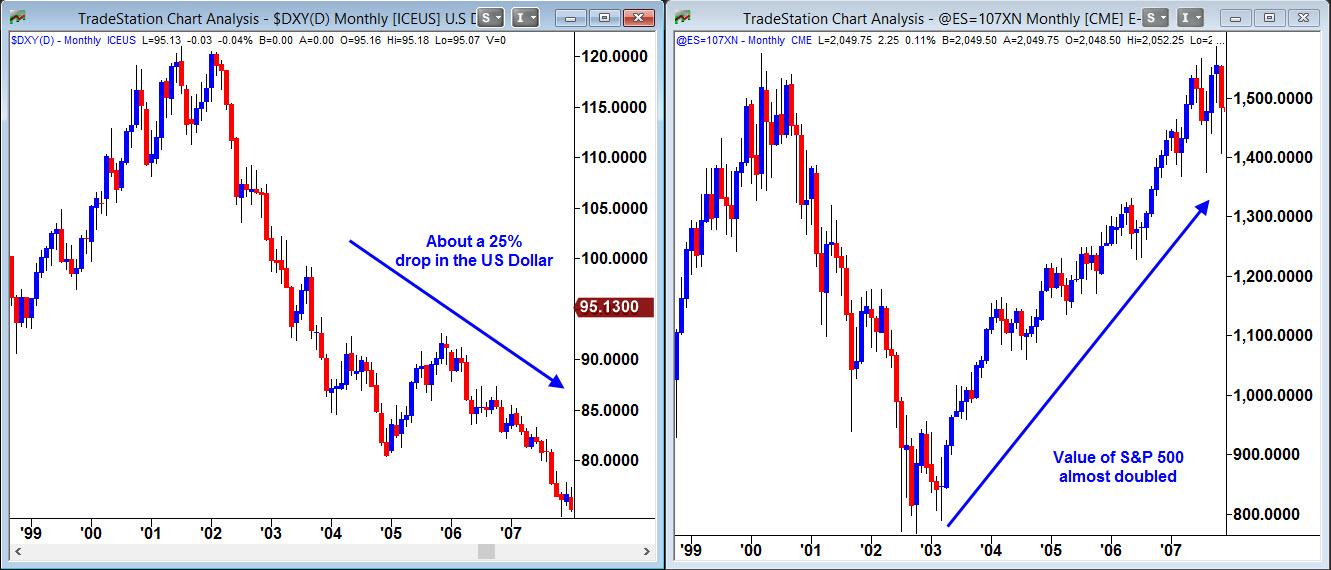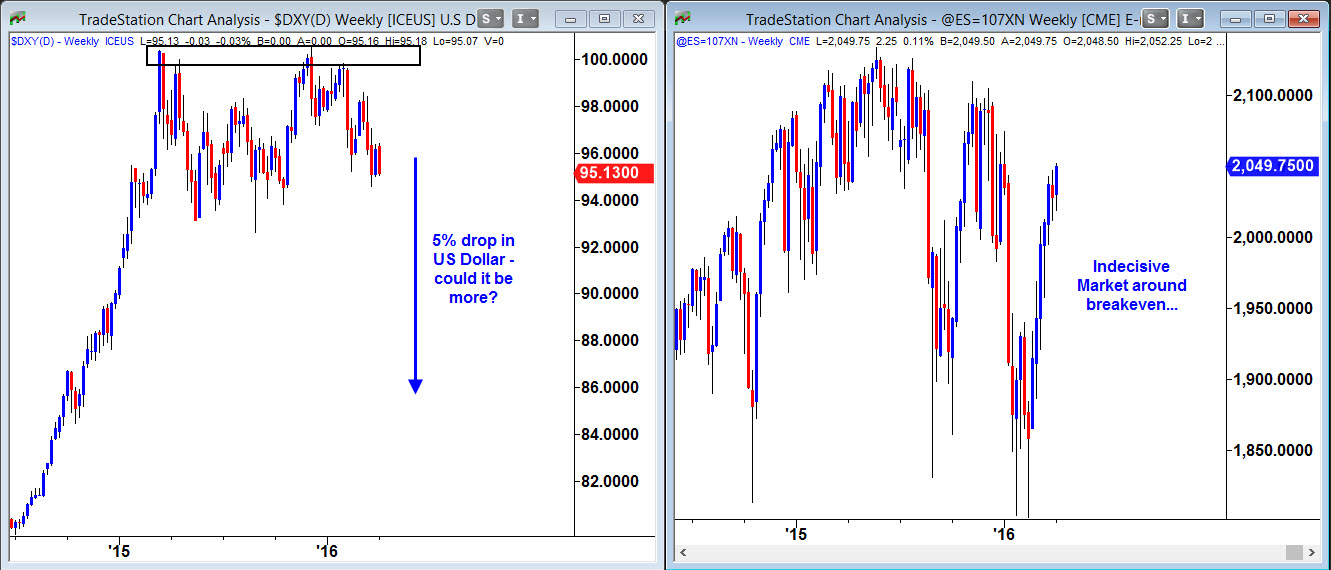Following a move to the USA, it led me to thinking more about the world of Forex Markets and how it has such a huge impact on all of our lives as a result of its movement, yet so few of us are even aware of just how important this impact really is.
Whether we like it or not, when we live in a particular country and are earning and saving as much of that nation’s currency as we can, we are effectively long that currency. If you live in Great Britain, then basically you are long GBP. If you live in Japan, you are long the Yen. And, if you live in the USA, you are long the dollar and you have a passive interest in the value of the dollar going up. Think about it like this: if you bought a stock and owned it for the long term, you are long that stock and hoping it will rise in value aren’t you? In fact, in an ideal world we would like everything we own would go up in value, but as we know this isn’t the case. Most things we buy are bought at retail prices and decrease in value over time, like cars, clothes and technology. There are exceptions like real estate; yet, as we know, this can lose value too from time to time. The interesting thing about this though, is that most people completely overlook the actual changes in value of the dollar; the one thing which pays for their home, the cars and everything thing else in between… namely their money. Let me explain this concept further.
Take a look at the S&P 500 Stock Index below on a longer term price chart as featured on the right hand side:

S&P 500
As we can see, the stock market rose significantly during the period of 2003 to 2007, just before the events of the great credit crunch. An investor who bought into the market during this period of time would have enjoyed a significant level of returns upon their capital. If you were educated enough to have bought near the lows in 2003 you would have seen practically a 100% return on your money, and who wouldn’t be happy with that (assuming you closed out and took profit before the sell-off in 2008 of course). However, as great as this is, I would like to draw your attention to the chart on the above left as well, as it tells us a very different story.
It is a chart of the US Dollar Index, basically showing the value of the US Dollar overall versus a basket of other global major currencies, such as the Euro, GBP and Yen to name a few. This chart, like any other chart, will show us institutional levels of supply and demand where the major banks and funds are buying and selling US Dollars. By knowing how to read this we can get a fairly good impression of just how valuable the Dollar is at any given time. Looking at the chart from the same period of 2003 to 2007, you will notice how the value of the dollar fell by around 25% at the very same time that the US Stock Market was rallying. What is the impact of this fall to the average investor? Any money that they made by being long on the stock markets was made in Dollars that were gradually being devalued and losing their buying power at the same time. Long story short, you were making money but that money was losing value as you were making it to the tune of 25% less buying power. That’s an impact which is often overlooked by most. And, let’s remember that I am not including the even bigger decline we saw from 2001.
So fast-forward to now. The Dollar has indeed recovered much of its lost buying power but, as we have seen, these are turbulent times in world markets for sure. We have seen a very rocky start to the trading year with volatility on the rise and much confusion and indecision surrounding market sentiment. It has been a lacklustre start with the US Markets sitting much around the price they opened in January. And what of the Dollar? Well, take a look below:

USD
The US Dollar has been testing and rejecting the 100.00 level of supply where institutions have been aggressively selling it for just over a year now. Sure we have not seen any major declines, but as of the time of writing this piece we are down about 5% as of Jan 2016, coupled with a stagnant S&P 500. If the Dollar fails to hold 92.00, then we could see even bigger declines. Applying a simple hedge of knowing when to buy and sell Dollars at key levels of supply and demand is a powerful cure for this conundrum; and having an awareness of prices in the bigger picture is all it takes to make sure your buying power does not suffer during the good times as well as the bad. I hope you found this helpful.
Sam Evans can be contacted on this link: Sam Evans
Whether we like it or not, when we live in a particular country and are earning and saving as much of that nation’s currency as we can, we are effectively long that currency. If you live in Great Britain, then basically you are long GBP. If you live in Japan, you are long the Yen. And, if you live in the USA, you are long the dollar and you have a passive interest in the value of the dollar going up. Think about it like this: if you bought a stock and owned it for the long term, you are long that stock and hoping it will rise in value aren’t you? In fact, in an ideal world we would like everything we own would go up in value, but as we know this isn’t the case. Most things we buy are bought at retail prices and decrease in value over time, like cars, clothes and technology. There are exceptions like real estate; yet, as we know, this can lose value too from time to time. The interesting thing about this though, is that most people completely overlook the actual changes in value of the dollar; the one thing which pays for their home, the cars and everything thing else in between… namely their money. Let me explain this concept further.
Take a look at the S&P 500 Stock Index below on a longer term price chart as featured on the right hand side:

S&P 500
As we can see, the stock market rose significantly during the period of 2003 to 2007, just before the events of the great credit crunch. An investor who bought into the market during this period of time would have enjoyed a significant level of returns upon their capital. If you were educated enough to have bought near the lows in 2003 you would have seen practically a 100% return on your money, and who wouldn’t be happy with that (assuming you closed out and took profit before the sell-off in 2008 of course). However, as great as this is, I would like to draw your attention to the chart on the above left as well, as it tells us a very different story.
It is a chart of the US Dollar Index, basically showing the value of the US Dollar overall versus a basket of other global major currencies, such as the Euro, GBP and Yen to name a few. This chart, like any other chart, will show us institutional levels of supply and demand where the major banks and funds are buying and selling US Dollars. By knowing how to read this we can get a fairly good impression of just how valuable the Dollar is at any given time. Looking at the chart from the same period of 2003 to 2007, you will notice how the value of the dollar fell by around 25% at the very same time that the US Stock Market was rallying. What is the impact of this fall to the average investor? Any money that they made by being long on the stock markets was made in Dollars that were gradually being devalued and losing their buying power at the same time. Long story short, you were making money but that money was losing value as you were making it to the tune of 25% less buying power. That’s an impact which is often overlooked by most. And, let’s remember that I am not including the even bigger decline we saw from 2001.
So fast-forward to now. The Dollar has indeed recovered much of its lost buying power but, as we have seen, these are turbulent times in world markets for sure. We have seen a very rocky start to the trading year with volatility on the rise and much confusion and indecision surrounding market sentiment. It has been a lacklustre start with the US Markets sitting much around the price they opened in January. And what of the Dollar? Well, take a look below:

USD
The US Dollar has been testing and rejecting the 100.00 level of supply where institutions have been aggressively selling it for just over a year now. Sure we have not seen any major declines, but as of the time of writing this piece we are down about 5% as of Jan 2016, coupled with a stagnant S&P 500. If the Dollar fails to hold 92.00, then we could see even bigger declines. Applying a simple hedge of knowing when to buy and sell Dollars at key levels of supply and demand is a powerful cure for this conundrum; and having an awareness of prices in the bigger picture is all it takes to make sure your buying power does not suffer during the good times as well as the bad. I hope you found this helpful.
Sam Evans can be contacted on this link: Sam Evans
Last edited by a moderator:
